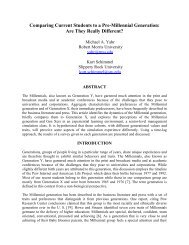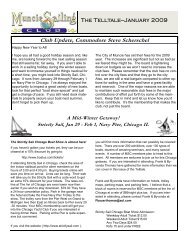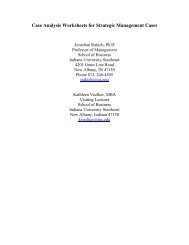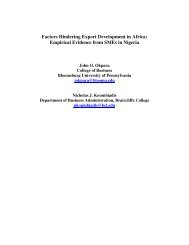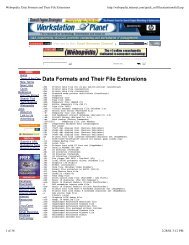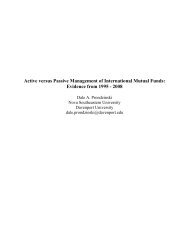Internet-based Applications from the Banking Industry
Internet-based Applications from the Banking Industry
Internet-based Applications from the Banking Industry
Create successful ePaper yourself
Turn your PDF publications into a flip-book with our unique Google optimized e-Paper software.
Understanding Market Concentration: <strong>Internet</strong>-<strong>based</strong> <strong>Applications</strong><br />
<strong>from</strong> <strong>the</strong> <strong>Banking</strong> <strong>Industry</strong><br />
Background<br />
Market structure is concerned with a spectrum of economic organizations that range <strong>from</strong><br />
pure competition at one extreme to pure monopoly at <strong>the</strong> o<strong>the</strong>r. In between are oligopolies with<br />
few firms and monopolistically competitive firms with many. So begins <strong>the</strong> discussion in most<br />
principles of economics classes. It does not, however, end <strong>the</strong>re. In marketing classes students<br />
are concerned with <strong>the</strong> impact of market structure on pricing decisions. In finance courses, <strong>the</strong><br />
focus may be on <strong>the</strong> impact that market structure has on <strong>the</strong> capital structure of firms and both<br />
<strong>the</strong>ir access to funds and <strong>the</strong> cost of financing. Entrepreneurship classes discuss <strong>the</strong> impact of<br />
competing in highly competitive markets while human resource classes may discuss how market<br />
concentration relates to compensation issues. The well-known strategic management works of<br />
Michael Porter are built around sustainability of competitive advantage that is linked to intensity<br />
of rivalry. (Porter, 1985) In short, issues related to <strong>the</strong> degree of market concentration are<br />
pervasive throughout contemporary business school curricula.<br />
The microeconomic <strong>the</strong>ory of <strong>the</strong> firm has been well developed and is typically<br />
introduced to students in principles of economics courses. For an illustration of a typical<br />
approach see O’Sullivan et. al. (O'Sullivan, Sheffrin, & Perez, 2010) The actual attempt to<br />
define and measure market concentration is often limited and in some instances is avoided<br />
entirely. As a matter of public policy, <strong>the</strong> measurement of market concentration is important and<br />
lies at <strong>the</strong> heart of decisions about whe<strong>the</strong>r to approve mergers and acquisitions that might pose a<br />
potentially harmful impact on consumers in terms of both prices and <strong>the</strong> availability of goods<br />
and services. (Bruner, 2004) These issues have been addressed by antitrust laws in <strong>the</strong> U.S.<br />
dating to <strong>the</strong> Sherman Antitrust Act in 1890. The Clayton Act in 1914, <strong>the</strong> Robinson Patman Act<br />
in 1936 and <strong>the</strong> Bank Holding Company Act in 1956 have each addressed various issues related<br />
to potential anti-competitive behavior. (Weston, Mitchell, & Mulherin, 2004)<br />
A popular measure of concentration is <strong>the</strong> Herfindahl-Hirschman Index (HHI) which is<br />
widely used by policymakers including banking regulators to evaluate merger proposals. The<br />
HHI is calculated as <strong>the</strong> sum of <strong>the</strong> squared market shares of firms in a given market. (Horizonal<br />
Merger Guidelines, 1997) Suppose <strong>the</strong>re are ten firms in a market in which each has a 10%<br />
market share. The HHI would <strong>the</strong>refore be (10) 2 + (10) 2 +.....+ (10) 2 =1,000. By contrast, a<br />
market with one firm that has a 50% share and five firms each with 10% share would have an<br />
HHI of (50) 2 + (10) 2 +(10) 2 +…..(10) 2 =3,000. A pure monopoly market with a single firm<br />
holding a 100% market share would yield an HHI of (100) 2 =10,000. Taken in isolation, <strong>the</strong>se<br />
numbers are meaningless. Viewed against guidelines, however, <strong>the</strong>y provide insight into possible



